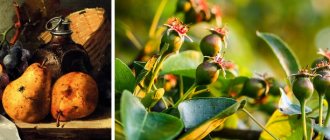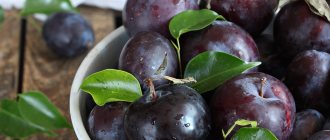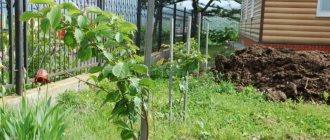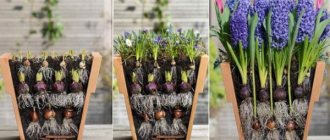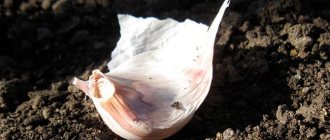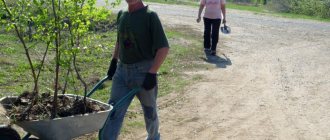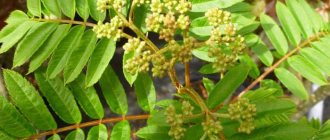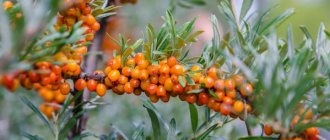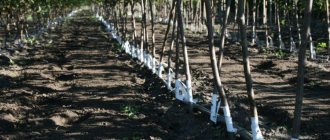Benefits of autumn planting
When planting plums in the fall, the climate zone, plum variety and soil of the area are taken into account. The further south the region, the better the young animals take root.
Benefits of replanting plum trees in the fall:
- plants are hardened and become resistant to temperature changes;
- The rhizome develops more intensively, rooting occurs faster, the tree does not waste energy on vegetation;
- autumn trees are 2-3 weeks ahead of spring trees in growth;
- enough time for work; in the spring, during mass plantings of different crops, time is very limited;
- water is saved, because rains are common during this period;
- trees take root easier and faster.
In spring there is intense movement of sap along the branches. Root development slows down. If the rhizome is poorly developed in a hot summer, the plum may die. Autumn seedlings are much cheaper than those purchased in the spring.
Plum care
In terms of care, plum varieties that are zoned specifically for the conditions of the Moscow region are practically no different from those bred for other regions. But in order to grow a beautiful and healthy tree, as well as get rich harvests from it, you need to pay attention to such points as:
- regular pruning;
- sufficient watering;
- timely feeding;
- proper preparation for winter.
Plum blossoms
Like other garden trees, plum trees also need pruning. It should be carried out annually with the onset of warm weather - in the spring or in the summer after the leaves bloom, so that the tree does not feel a sharp change in temperature. When pruning, dry, damaged, excess and vertically grown branches are removed. It is important to try to avoid damaging the cortex during this procedure, so as not to provoke the development of diseases. And be sure to coat all cut areas with garden varnish. Proper pruning can help:
- stimulating tree growth;
- formation of large fruits;
- in the fight against various diseases.
Advice.
It is better to carry out pruning with a well-sharpened knife or other sharp tool, this way the tree bark is significantly less damaged. In addition, it would be more correct to cut the branch rather than saw it off. Watering is an important component of caring for this fruit crop. Plum is a plant that loves moisture. It is necessary to provide the tree with the necessary amount of water during the summer and early autumn so that the soil is always moist. Due to lack of moisture, the fruits usually crack. You can tell about excessive watering by yellowed leaves and dried tops. Along with water, the necessary fertilizers are also added.
Pruning plum
Preparation for cold weather is also an important factor, because even winter-hardy varieties can suffer from low temperatures. It is recommended to cover the soil around the tree for the winter with leaves or hay, as well as snow, but at the same time avoiding excessively throwing it over the trunk so that the bark on it does not dry off in the spring.
Autumn landing time
The timing of planting directly depends on the area where the trees grow, climatic and weather conditions. In autumn, plum seedlings are planted 1.5 months before the soil freezes.
In the south of the country, the first frosts occur in mid-November, so you can plant plums in October. These are the Krasnodar and Stavropol territories, Rostov and Astrakhan regions.
Important! If you plant a seedling a few days before frost, the plant will die.
Primorye is the second climate zone. There is snow here in September, but stable frosts come in November. Planting is done throughout October.
The Siberian region is famous for its early frosts - in September. Therefore, it is recommended to plant young plants in August. In the Moscow region, planting is carried out at the end of September - beginning of October.
In temperate climates (Irkutsk, Arkhangelsk, Tyumen regions), snow cover covers the ground at the end of October. Trees are planted in early September. It is better to plant regional cold-resistant varieties; they will survive in the conditions to which they are adapted.
Timing for planting plum seedlings in open ground
Autumn and spring planting of any fruit crops and shrubs should be carried out at the most suitable and comfortable time for them. The survival rate largely depends on this. When is it better to plant this fruit crop, in what month?
The optimal time for planting plums in the spring is in March or April before the buds open, but the air temperature should be consistently above 5 degrees Celsius. In the middle zone (Moscow region) - it is optimal to plant at the end of April, in the South (Krasnodar Territory (Kuban), Northern Caucasus) - at the end of March, in Siberia, the Urals, Leningrad region - it is better to plant at the beginning of May.
The recommended time for the procedure in the fall is usually September-October, the daytime temperature should be about 10 degrees Celsius, and the night temperature should be 5. It should be planted one month before the onset of cold weather. In Siberia, the Urals, and the Leningrad region, it is better to plant in September, in the South - throughout October, in the Middle Zone - from the end of September until the end of the first half of October.
By the way! The natural desire of any gardener is to find out: at what year after planting does a plum tree begin to bear fruit? So, as a rule, fruiting begins after 3-5 years.
Varieties
About 250 varieties of plum trees have been developed. If previously the plum was considered a southern tree, now zoned hybrids with 100% survival rate have been bred. They produce good harvests both in northern latitudes and in southern regions.
| Region | Name of plum varieties |
| Central Russia | Hungarian, Ussuri, Renklod, Chinese, Giant, Bluebird, Svetlana, Smolinka |
| Moscow region | Bogatyrskaya, Hungarian Korneevskaya, Volgogradskaya, Mirnaya, Zarechnaya early |
| Ural and Siberia | Pearl of the Urals, Uyskaya, Ural yellow, Kuyashskaya, Shershnevskaya, Chebarkulskaya, Aylinskaya, Uvelskaya, Mikhalchik, Ural prune, Pioneer, Vega, Ural golden, Pride of the Urals, Chemal's Gift, Golden Niva |
| South of the Country | July, Golden Ball, Zarechnaya early, Skoroplodnaya, Souvenir of the East, Romain, Renclod, Svetlana, President, Empress |
| Leningrad region | Red ball, Renklod collective farm, Tula black |
Svetlana plum was bred by seaside breeders; it tolerates frost easily and produces stable yields. The fruits are yellow, round, one weighs 26-28 g. It begins to bloom after May 10. The harvest is harvested in August. Sweet taste with sourness, the bone is separated from the pulp. One tree can produce up to 30 kg of plums. The first fruits are harvested in the 5th year of life.
Giant is a fast-growing, high-yielding variety. Fruits appear in the 3rd year when a two-year-old tree is planted. It has subspecies with burgundy, yellow-orange, and purple fruit colors. The pulp is sweet. Harvest in mid-September, fruits weighing up to 100 g.
Hungarian - prunes are made from this species. Varieties: Italian, Voronezh, Michurinskaya, Belarusian. Medium-sized trees reach a height of up to 4 m. The first fruits grow at 6-7 years of age, large up to 5 cm in length, elliptical in shape. Color lilac, violet, blue. The harvest is harvested at the end of August. Drought-resistant variety, life expectancy 25-30 years.
The pearl of the Urals is a winter-hardy plum, resistant to drought, and characterized by high yield. Chinese fruits size 25 g, they have dense, sweet pulp. Pearl bears fruit in the 4th year of life, 17-19 kg of fruit from each tree.
Precocious - plums appear in the 3rd year of life. A tree lives for 20 years. Harvest - up to 10 kg per plant. There is a bad harvest every 3 years. The weight of one fruit is 20-30 g, round in shape, yellow-orange color with a red side. The pulp is yellow, aromatic, sweet with sourness.
You may be interested in:
Cherry “Revna”: description of the variety, photo Today it is difficult to find a plot of dacha where cherries do not grow, but there are quite a few species of this tree, it...Read more...
Adapted varieties for Siberia
Only frost-resistant varieties are selected. It makes no sense to plant unadapted species that will die in the first winter. The most suitable plum varieties for Siberia are presented in the table.
| Variety | Description |
| Ussuriyskaya | Has high resistance to frost. Requires constant moderate soil moisture: excessive watering leads to the death of the seedling, and insufficient watering reduces frost resistance. |
| Russian | This is the best plum variety for Siberia. The seedling tolerates even extremely low temperatures. The species was obtained by crossing and is distinguished by high frost-resistant characteristics. The fruits are small in size, but have a pleasant taste. |
| American | This species can withstand temperatures down to -35 degrees. The seedling can survive for a long time without watering. The fruits are sweet and sour. |
Be sure to first find out which variety of plum to plant in Siberia. Only artificially bred varieties are suitable for harsh climates.
Optimal growing conditions, site selection
During the first 4-6 years, the plum tree takes root and produces little fruit. The productive period is from 10 to 20 years of life. After 17-20 years, the harvest begins to decline and the tree ages.
Plum loves light and should be planted in a well-lit place. Cold air accumulates in the lowlands, which can harm the plant. Near the house or fence, the plum tree will be protected from the wind.
Plum is relatively drought-resistant and moisture-loving. Do not plant it in stagnant soil, as the roots may rot. If groundwater is located at a depth of 1.5 m, then liquid drainage is needed on the site.
Next to other fruit trees, a young tree may not survive. Mature plants will take all the moisture and nutrients.
Selection of seedlings
Choosing the right variety of plum seedling guarantees half the success when growing. It is best to purchase varieties from local nurseries or neighboring areas. When purchasing, you must carefully inspect the seedling. It should be:
- about 60-80 cm in height;
- have several roots;
- be aged 1-2 years;
- bark without cracks, burns, signs of disease;
- root without rot or damage.
Reanimation of a seedling
In some cases, when purchasing a seedling in a pot that is substandard or not watered on time, it dries out. Such seedlings are brought back to life in several ways:
- The seedling is completely immersed in a barrel of rainwater for several days. Sometimes it helps.
- Dissolve 15 drops of camphor alcohol in 200 ml of water. Pour into a barrel of water and soak the seedlings for 48 hours.
- Preparation of “living water”. Dissolve 20 g of urea, 20 g of superphosphate, 2-3 drops of root former in a bucket of water, mix, pour into a barrel of water and soak the seedlings for 16-20 hours.
- Before planting, the shoots are shortened; the balance between the underground and above-ground parts will allow the roots to quickly settle into the ground and provide nutrition to the top.
Attention!
The seedling thus revived needs to be planted in loose, fertilized soil, good watering and additional care.
Choosing a location and neighbors
Plum likes neutral loamy or sandy loam soils with a fertile layer and constant nutrition. Plant the tree on a high place or on an artificially made ridge. It loves sunlight, but has a negative attitude towards drafts, so it is recommended to plant it on the south side of the house or fence, which will protect it from the wind. But when choosing a location, the neighbors already growing in this place are taken into account. Plum does not like cherries, nuts, or pears next to it. Her fruiting is deteriorating. Plum bears fruit remarkably well if you plant cherry plum nearby. This proximity has a beneficial effect on both trees, since they need pollination. In addition, plum and cherry plum can be grafted onto each other.
Preparing the pit for planting
The hole is dug 2 weeks before planting the plum tree to allow the soil to shrink. If the site is low, its depth is about 1 meter and width about 60 cm. The top layer of soil is set aside and the bottom layer is removed. A drainage layer in the form of expanded clay, broken bricks, and pottery shards is placed at the bottom of the pit. The top layer is mixed with humus, compost, peat, and ash. 200 g of superphosphate and 100 g of potassium sulfate are also added there.
Attention!
If a plum orchard is being established, the distance between trees should be at least 3 meters.
Soil preparation
The soil is recommended for plums with a pH of 6.4-7. Preference is given to clay and loamy soils. It grows successfully in soil with a high calcium content; it does not like acidic soils. If the environment is acidic, add dolomite flour, wood ash, and lime to the soil - 500 g of the substance per square.
Composition of soil for the pit:
- top layer of earth;
- potassium – 15 g;
- humus – 12-15 kg;
- superphosphate – 70 g;
- river sand;
- gravel for drainage.
Having dug a hole 50 cm deep and 50 cm wide, place a peg and pour in the prepared nutrient mixture.
When to plant a plum in the fall so that it takes root?
For successful development and fruiting, any fruit tree or plant must be planted on time and provided with the necessary nutrition and care. Otherwise, you may not get a harvest even in 10 years. This is exactly how a plum behaves if it is planted incorrectly and not provided with the necessary watering and fertilizing. She does not please the owners with the harvest or dies. Young gardeners often make mistakes when planting them, neglecting advice and rules.
Purchase of planting material
It is better to buy seedlings in specialized nurseries. They grow trees with grafted varietal petioles. These seedlings begin to bloom and bear fruit earlier. Choose material without rotten roots to look healthy. Young animals raised in the spring are not suitable for autumn transplantation.
Criterias of choice:
- total height up to 1.2-1.5 m;
- the trunk is smooth, the bark is intact;
- what type - self-fertile or self-sterile;
- trunk length to branches – 55 cm;
- lifespan from one to two years;
- trunk girth at a height of 12 cm from the grafting site is 1.5-2 cm;
- roots - 5-7 pieces, 20 cm long.
Important!
You should not buy trees whose main root has been cut off very close to the trunk.
The necessary process for planting plum trees in the fall is to remove leaves from the shoots. Thanks to the procedure, the seedling consumes less moisture and the branches do not dry out. If the young plants were purchased a few days before planting, then the rhizome is covered with a wet cloth and is not removed until planting. You can put the roots in water for 2 hours, but no more.
Climatic features of the region
The climate of Siberia requires the cultivation of exclusively cold-resistant plant species. Breeders have developed many types of plums that meet this indicator, but are characterized by other disadvantages:
- due to frequent temperature fluctuations, the buds of trees freeze, so only varieties with a long dormant period can be planted in cold climates;
- strong winds dry out the shoots;
- the absence of severe frost and an abundance of snow contribute to the rapid death of the lower part of the plum trunk, and even removing snow does not save the situation: in this case, the root system freezes.
After a series of studies, it was concluded that fruit trees are best grown in steppe areas or where moderate amounts of snow fall.
Planting seedlings
The entire garden or vegetable garden is dug up in the fall. All weeds must be removed from the site.
Step by step guide:
- Having chosen a site, dig a hole 50 cm by 50 cm and 60 cm deep.
- The hole is dug two days before planting the tree.
- Sand and drainage are poured into the bottom, a stake is driven into the center, to which the seedling is tied.
- A gap is left between neighboring plants of 3 meters.
- Part of the excavated soil is mixed with fertilizers and poured back into the hole.
- Make a mound and place the seedling, straightening its roots so that the graft is 3 cm above ground level.
- The distance from the stake to the trunk is 5-7 cm.
- Having filled the hole with earth, lightly tamp it down and water it generously with 8-10 liters of water.
- Cover the top with mulch - hay, sawdust, peat. This will keep the fruit plant from freezing.
If it is not immediately possible to plant a plum in a permanent place in the fall, then the tree is dug in at an angle. Completely cover with earth and peat; you can use foliage for insulation. In the spring, the seedling is transplanted to a new location.
Post-planting care
Without proper care after planting, the tree finds it difficult to take root, develops slowly, and then bears fruit poorly.
To prevent this from happening, you need to properly care for the tree, regardless of the planting date.
- Watering . Lack and excess of moisture are equally dangerous for plums. If there is a lack of water, the tree will begin to dry out; if there is excess moisture, it may die due to the development of fungal diseases. Therefore, seedlings need to be watered regularly and abundantly. During one watering, 4-5 buckets of water are poured under the tree to wet the soil to a depth of 40-50 cm.
- Mulching . If the tree trunk circle was not mulched during planting, this work can be done a little later. Peat and humus are used as mulching materials.
- Feeding . If the preparation of the planting pit was carried out in accordance with our recommendations, the plum tree will not need fertilizing in the next 2 years of its life. The supply of food that was laid down when preparing the soil will be enough for 2 seasons.
- Loosening . This operation is required when plums are planted in the spring, since there is still quite a lot of time left before winter. As a result of this agricultural practice, air nutrition of the roots improves. Loosening is performed one day after the next watering.
- Shelter. In order for a young plum to successfully overwinter in Transbaikalia, the Moscow region and other areas with frosty winters, it needs to be covered:
- the trunk of the tree is wrapped in burlap;
- the tree trunk circle is mulched with sawdust;
- sheets of slate are placed on top of the mulch layer;
- In winter, they push snow towards the tree and compact it.
Armed with new knowledge about how to properly plant and post-plant care for plum trees in various regions of Russia, you can proceed directly to the planting procedure. Planting a garden is a good investment of labor and money. Such investments will definitely pay off and bring the expected income and satisfaction.
Care after landing
Careful care will prepare the young animals for the winter; they will not freeze. They carry out basic activities that help strengthen the roots, subsequently obtain stable yields and protect the plant from harmful insects and diseases.
Trimming
Autumn pruning of the crown is done in the first half of September. If you prune the branches later, the tree will not be able to recover before the cold weather. Circumcision shapes the future crown. When long shoots are left, they can break from the wind.
Trimming process:
- At the first pruning, the branches are cut by 1/3.
- Fast-growing branches are shortened by 2/3.
- Dry, diseased shoots are removed.
Use sharp pruning shears and gloves. Without the formation of the crown there will be no beautiful blooming appearance next year. Use a simple pruning pattern.
Disease Prevention
Most often, plums suffer from gray rot and holey spotting. Yellow spots with a brown border appear on the leaves. Then holes appear, the fruits crack and rot. After the leaves have fallen, you can treat the trees with Bordeaux mixture (3%). The treatment is repeated in the spring until flowering.
Whitewashing trees
For the winter, it is better to whiten the trunk with a solution of lime. This will help the tree survive frosts and temperature changes. Solution recipe: 3 kg of lime and 2 kg of clay are diluted in a bucket of water. Stir thoroughly, dip a paint brush into the lime and cover the trunk with it.
Attention!
For young animals, it is better to use foil instead of whitewashing.
Pest protection
The plum tree is pestered by plum aphids, goose, fruit mites, and black ants. As a preventive measure, a tincture of wormwood, onion peel, garlic and soap is used.
Recipes:
- One liter of boiling water is poured into a container and a full liter jar of onion peels is poured into it. Leave for 48 hours. Before spraying, filter, then dilute with water 1:2.
- 6 cloves of garlic are poured into a liter of water and left for 24 hours. Before use, add 6 g of household goods. soap
- Prepare ash water (a glass of ash per 9 liters of water), add 6-7 cloves of chopped garlic, mix and leave for 5 hours. Add 1 tablet of microfertilizers and 50 g of mineral additives, and spray the plants with the product.
- In case of severe insect infestation, treat the crown with a 5% urea solution. Spray all branches.
Fertilizer
If the planting was done according to all the rules, then the plum will have enough nutrition for the first year of its life and does not need additional feeding. In spring, fertilize with urea 25 g per square meter. The first feeding is carried out in the fall at the 2nd year of life.
Watering
The plum root system is close to the surface of the earth. If the groundwater is deep, then the ground is moistened to a depth of 1 m. Before winter, if there was a dry summer, in September each young plant is watered abundantly: 4-5 buckets per specimen. Watering is necessary for better wintering. If there is a lot of precipitation in September, then watering should be abandoned. Don’t forget to make drainage grooves so that rainwater does not accumulate in the planting hole.
Important!
If the autumn is warm and there is a lot of moisture, the growth of branches and the appearance of new leaves can be observed, which is harmful for the wintering of trees.
Instructions for planting plum seedlings
When planting any fruit tree, you must follow a certain pattern that will help you complete the procedure correctly. In addition to the planting itself, every step is important: choosing planting material and a place in the garden, preparing the hole.
Selection of seedlings
Plum was originally a heat-loving and fastidious crop, but thanks to selection, adapted, frost-resistant varieties appeared. Therefore, to grow fruit crops from the Middle Zone, the Urals, and Siberia, it is necessary to select zoned varieties suitable for the weather and climatic conditions of a particular region. There is no point in buying seedlings intended for other regions, because most likely they will not take root or will bear fruit poorly.
Choosing an adapted variety suitable for a specific region is the key to normal tree growth and fruiting.
The characteristics of a healthy, good plum seedling will help you choose a suitable specimen for autumn or spring planting:
- The above-ground part of the plant must be healthy - without damaged, dry shoots. There should be no signs or traces of disease. The bark has no damage, its integrity is preserved.
- A healthy and powerful root system with three to five strong roots at least 25 centimeters long. Also, the central conductor must be well developed. The seedling should not have dry or rotten roots or suspicious growths.
- The seedling must have a semi-dwarf or dwarf rootstock.
- The optimal age of a seedling is one or two years. You cannot plant specimens older than three years, as they most likely will not take root.
- The diameter of the seedling trunk is 1-1.5 centimeters.
- The seedling has a central shoot and at least three lateral branches.
Important! When purchasing a seedling, also check with the seller whether the variety is self-pollinating or cross-pollinated. If the seedling belongs to the latter type, then one or two more plum seedlings of different varieties should be planted on the site.
Selecting a location
The place where you choose on the site will serve as a home for the tree for many years. And the quantity and quality of the harvest will depend on how comfortable it is for him to grow in this place. The following recommendations will help you choose a place:
- The place should be sunny, the south or south-west side of the garden is ideal (the absence of sun is critical for this crop, shadow can have a very negative effect on the harvest).
- Also, the place for the plum must be reliably protected from the wind, which is very critical and unpleasant for the crop.
- Stagnation of moisture and excessive moisture are not acceptable, so wetlands and places with high groundwater levels should be avoided (suitable depth is at least 1.5 m).
- You should not choose a place to plant plums close to tall trees with a wide, spreading crown, as they will cast a large shadow.
Soil selection
The crop can grow on different soils, but they must have the following characteristics:
- Fertility;
- Looseness;
- Neutral pH - 6.5-7
If the soil in your area is too acidic, the situation can be corrected. Apply wood ash or dolomite flour (0.4 kg per square meter) to the soil. For clayey soil, sand should be added, and for sandy soil, on the contrary, clay.
The best option for growing a tree is sandy, loamy soil . If there is a lack of nutrients in them, then it is necessary to fertilize in a timely manner.
Recommended distance between trees
The distance between trees in a garden is the key to a successful vegetable garden. After all, trees that compete for resources and interfere with each other are unlikely to produce a bountiful harvest. Therefore, it is so important to consider the optimal planting scheme.
The recommended distance between plum seedlings when planting is at least three meters. If you have chosen a tree variety that reaches large sizes, then it is recommended to increase the distance to 8-10 meters. And also trees should not be too close to buildings and fences.
Important! Also, when planting in open ground, it is necessary to prevent an unfavorable neighborhood. You should not plant plums next to cherries, sweet cherries, pears, and walnuts. Such neighbors will inhibit growth and fruiting.
Preparing the planting hole
The planting pit should be prepared in advance. If planting is planned in the spring, then preparation is carried out in the fall, and if in the fall, then in the summer or a month before the event. But it also happens that the gardener cannot prepare the hole in advance, so this needs to be done at least 3 weeks in advance. First you need to level the area and remove weeds.
Then you need to forge a hole. The recommended dimensions of the planting hole are 60-70 centimeters deep, 70 centimeters wide . When digging a hole, throw the soil from the top fertile layer in one direction, and the rest of the soil in the other.
At the bottom of the planting hole, make a drainage layer 10 centimeters thick . You can use crushed bricks and expanded clay.
Then you need to add fertilizers , which will serve as a good source of nutrients when planting plums in spring and autumn. It is recommended to add the following ingredients: superphosphate (250 grams), humus (1 bucket), top fertile layer of soil (1 bucket).
After pouring fertilizer, place a wooden peg on the side of the hole, which will serve as a support for the young tree. When choosing a location for a peg, keep in mind that there should be a gap of 15 centimeters between the peg and the seedling.
Direct planting of plum
If you have completed all the preparatory activities and waited for the deadline, it is time to carry out the activity. Step-by-step instructions will help you plant a plum seedling according to the correct pattern:
- Place the seedling in the planting hole and straighten the roots.
- Fill it with soil; you can shake the trunk slightly to avoid the formation of voids. The grafting site should face south, and the root collar should be 3-4 centimeters above the ground surface.
- Lightly compact the planting area.
- Water using four buckets of water.
- After absorbing the water, mulch the tree trunk circle.
Planting a seedling with a closed root system (that is, a container type) is carried out in the same way, but the tree must remain at the same ground level as it previously grew in the container.
Video: how to plant a plum seedling correctly.
Preparing for winter
Before winter, the soil is loosened and all weeds are removed. A fragile tree may not survive severe frosts. If severe frosts are expected, the seedling is covered with spruce branches or covered with poles, forming a hut. Straw, hay, and sedge are placed on top. Then the structure is secured with rope. Such a shelter will protect not only from the cold, but also from the wind and sun.
Mulch the soil surface with sawdust, hay, and peat. To prevent rodents from peeling off the bark, mint sprigs are inserted into the hut.
If there is no covering and the winter is snowy, shields are placed around the tree. When snow falls, it will not be blown away by the wind. A large layer of snow will insulate and provide moisture to the roots. If the snow layer is more than 60 cm, then it is reduced.
You may be interested in:
Pear Simply Maria: description of the variety, reviews If a gardener wants to find a fruit tree for his plot that can easily withstand cold winters, he can...Read more...
Possible difficulties of cultivation
You may be interested in: Plum seedlings - how to choose and careWhat is a sloe, its varieties and methods of growing in the gardenThe purposes of plum grafting and the advantages of the procedure
Siberia has unpredictable climatic conditions. When growing fruit trees, you are likely to encounter:
- Poor resistance of the plant to frost, in which the bark is dried out by strong winds. The tree will get sick or die.
- Temperature changes that lead to kidney death.
- Rotting of the roots when a lot of snow falls and the soil has not yet had time to freeze.
Plum trees in Siberia will fully grow and bear fruit if all planting recommendations are followed.
When is it better to plant plums in spring or autumn?
Both methods have their merits. But autumn planting is superior to spring planting in this regard. The main advantages of autumn planting:
- plants are less sensitive to damage;
- the soil is compacted when the buds emerge in the spring;
- during spring activation there is no impact on the tree, it has already taken root;
- fresh planting material;
- fruits appear earlier than those of spring seedlings.
It is important that the tree removed from the nursery in the fall was delivered after the growing season had ceased. And the spring material was disturbed during the period of bud swelling. The root system of an autumn plum will not experience stress. There is a minus - you can never predict the weather in winter. In severe frost, the young plant may die.
If the plucked trees were not immediately sold in the spring, then activation of buds and growth may begin before planting in the soil. When planting in spring, young plants must be pre-soaked; this takes time. Therefore, when to plant a fruit tree is up to you to decide.
Planting plum seedlings in the spring in the middle zone. in autumn
Planting plum seedlings in the fall is carried out in regions with a warm climate. In the regions of the Trans-Baikal Territory, Siberian regions, and the Urals, it is not worth taking risks, since there is a fear that the seedling will not have enough time to take root before the onset of frost. In this case, inevitable death awaits him.
Autumn planting of plum seedlings in the Moscow region is usually carried out in the second half of September.
Autumn planting starts in mid-September and ends in the first ten days of October. There should be at least a month left until the cold weather hits. This time is usually enough for the young plant to take root.
Benefits of autumn planting:
- the seedling is at rest, the procedure takes place without stress;
- the ability to comply with all planting rules, since there is no particular rush and the gardener is not overloaded with other work;
- a wide selection of good seedlings of zoned varieties;
- a seedling that has taken root in the fall immediately begins to grow with the onset of a favorable spring period;
- In autumn, seedlings take root better, since the sun is not so active and moisture evaporation is minimal.
Autumn planting has one very significant drawback - if you make a mistake in choosing the planting date or if the autumn cold comes earlier than usual, the seedling will freeze in the winter before it has time to take root.
When does a plum tree begin to bear fruit after planting seedlings? If you follow the technology of planting procedures and the rules of crop care, the first fruits will appear in the 3rd, 4th or 5th year.
Features of planting in the regions
Choosing a zoned hybrid that is resistant to the weather conditions typical of such an area will allow you to get tasty fruits in the future and give good yield indicators.
In the Volga region and the Middle zone
In these areas, winters are not very frosty. Trees are planted in mid-September. Preference is given to varieties resistant to cluster blight and moniliosis. It is better to plant plums on the south side of the site on light loamy soils.
In the Siberian region and in the Ural region
In the Siberian Territory and the Urals, it is not recommended to plant plums in the fall; frosts begin early. Only zoned and winter-hardy varieties are used.
You can plant the seedling in a bucket and transfer it to the basement; the temperature should not fall below 3-5 degrees below zero. Don’t forget to water the plant and provide additional lighting. And at the end of April it is better to transplant the plum to a permanent place.
Planting plums in Siberia in spring. Climatic conditions in Siberia for planting plums
Siberia is a special region, characterized by long and cold winters and unexpected summers, so the cultivation of plums in these parts is different from cultivation in other regions and is entirely focused on difficult natural conditions. The climate of different regions of Siberia has its own distinctive characteristics, and varieties that have proven themselves well in the Altai Territory may not take root in the Novosibirsk or Tomsk region. Plum is much more comfortable where the snow cover is moderate in winter. It is not the winter frost that is dangerous to the crop, but the temperature changes in the spring.
Cold-resistant varieties of plums tolerate Siberian frosts well, but during spring temperature changes from frost to thaw and back, the buds often freeze on the trees. Also unfavorable for the crop are winter damage such as damping off (death) of the bark on the bottom area of the tree trunk and freezing of the root system. The death of the bark occurs when there is abundant snow cover around the tree, which, moreover, cannot be removed, since this will lead to freezing of the root system; all that remains is to freeze the soil around the tree.
The next problem is freezing of the upper segment of the tree, so it has to be insulated with spruce branches or covering materials. In addition to these difficulties, there are also seasonal strong winds that dry out immature annual shoots. Based on this, steppe regions and certain small natural zones with a small amount of snow are most suitable for the cultivation of plums - the south of the Altai Territory and the Omsk region, but in the Novosibirsk and Tomsk regions they are unfavorable for growing plums.
Possible mistakes when planting plums
No one is immune from mistakes when planting autumn seedlings. Even experienced gardeners can make mistakes.
Main mistakes when planting plums:
- Plant plum trees at an angle in the fall. This should not be done, the wind can break the seedling.
- Fearing that not enough fertilizer has been applied, they are trying to make additional fertilizing. Overfeeding plants is dangerous for young animals.
- Excessive watering can lead to rotting of the rhizome, or freezing during early frosts.
- Varieties for this area are not taken into account.
With proper transplantation and further care, after a few years the plum will delight you with a bountiful harvest. The first year is the most important for the further growth of the plum tree. If the tree calmly overwinters and takes root, then its development depends on watering, fertilizing, protection from insects and diseases, and preparation for winter.
Selection and preparation of a site
The peak yield of any type of plum occurs at 12-15 years; until this time, fruiting will be mediocre. However, much depends on the location: if you plant a plum in the fall in conditions favorable for growth, then abundant harvests will begin earlier.
The following areas are best suited for white plums and prunes:
- sunny, without shading (light partial shade is acceptable in the morning or evening);
- structures located near a fence or wall;
- flat, without lowlands in which melt and rain water would accumulate in the spring.
The soil must be well-permeable to moisture - plums do not like drought, but they also do not tolerate stagnation of water and may respond by dropping inflorescences and leaves. It is not advisable to plant plum trees in the fall near large trees - they will absorb nutrients and the tree will begin to lag in growth.
Soil acidity within the pH range of 6.5-7.2 is considered optimal for cultivating different types of plums.
Rules of care
In order for the plum to develop normally and fully, it should be provided with high-quality care.
Irrigation
This culture is considered quite moisture-loving. It does not tolerate excess or deficiency of moisture equally well. In hot weather, it is recommended to water the plum at intervals of 5-7 days. A young tree requires 3-4 buckets of water, for an adult crop the norm is increased to 5-6.
Fertilizer application
The crop needs timely application of fertilizers. It is recommended to focus on the following features:
- For 3 years after planting, the use of urea is sufficient for the plant. Take 20 grams of product per 1 square meter.
- At the beginning of fruiting, a composition of 25 grams of urea, 30 grams of superphosphate, 300 grams of wood ash and 10 kilograms of manure is added.
- In spring, an adult plant needs to use humus, manure or urea. In the autumn, it is recommended to apply compounds based on potassium and phosphorus.
Loosening and mulching the soil
During the first 2 years after planting, the soil must be systematically loosened. During the procedure, it is worth adding 1 bucket of humus or peat. Mulching is used to retain moisture in the soil and eliminate weeds. For this, grass, sawdust, and leaves are used.
Diseases and pests: treatment and prevention
In the Leningrad region, plum trees can suffer from the following diseases:
- Moniliosis - flowers, branches, buds, and trunk suffer. The bark of the tree becomes covered with gray growths, the foliage darkens and crumbles.
- Rust is a fungal infection in which the leaves become covered with brown spots with a yellow border.
- Gum discharge – affects tree trunks and shoots. There is also a risk of fetal infection.
- Clusterosporiosis - fruits become covered with black and gray spots. After some time, gum formation occurs.
- Aphids - these parasites absorb plant sap.
- Gall mite - infects tree leaves and absorbs their sap.
Insecticides help control parasites. For this you can use Iskra, Actellik. Fungicidal drugs are used for fungal infections. Affected pieces of wood should be cut off and burned.
Choosing a plum variety
When purchasing seedlings in nurseries and markets, attention is paid to regionalized varieties that are resistant to frost, diseases and pests. In addition, in the middle zone and Moscow region, you can plant plums by choosing early and mid-early varieties in order to have time to harvest the main crop before frost arrives. The following plum varieties are suitable for these regions:
All these varieties bear fruit from mid-July to the end of August, are winter-hardy and, if grown correctly, will delight their owners after 3 years. The fruits are used as desserts, for making jellies, compotes, jams, and they can, if necessary, withstand transportation over long distances.
The intensity of fruiting and the quality of the fruit depend on proper care in the spring. Basic procedures on site...
When planting a plum in Siberian conditions, due to the small amount of snow cover and strong winds, the seedling experiences:
- freezing of the top;
- drying out of shoots;
- damping off of roots and cambium;
- winter thaws, leading to swelling of the buds and subsequent sharp frosts, kill the waking plant.
Therefore, frost-resistant varieties of plums are planted in Siberia:
Choosing a plum variety for planting in the Leningrad region in open ground with rainy summer weather, rare sunny days, high humidity levels and winter frosts is a difficult task. Not all varieties will withstand such negative influences of nature. For a plum to produce a harvest under such conditions, it must be:
- resistant to temperature fluctuations;
- self-pollinate;
- early variety;
- resistant to diseases and pests;
- compact size.
Preference is given here to early varieties and grown:
- Red early ripening;
- Gift to St. Petersburg (hybrid of Chinese plum and cherry plum);
- Alyonushka:
- Etude.
Disembarkation
in autumn
When the preparatory work is completed, you can proceed directly to planting. Planting is carried out in holes dug a month ago, according to the following algorithm:
- if the mound in the hole was not made in advance, it is made from prepared soil;
- a stake is driven into the hole to secure the seedling;
- put a seedling on a mound, straighten the roots in all directions;
- cover the roots of the tree with the prepared soil mixture;
- during the process of burying, the tree is shaken a little to eliminate possible voids in the soil;
- make sure that the root collar does not go deep into the ground; if this happens, the seedling is slightly pulled out of the ground;
- the soil around the tree is lightly crushed;
- do abundant watering;
- tie the tree to a peg;
- a parapet around the tree trunk is made from the remains of the soil so that irrigation water does not spread;
- The tree trunk circle is covered with mulch from sawdust or compost.
Pruning and shaping plums
To increase the fertility of the tree, plums are pruned in autumn, summer, and spring. She loves to weave branches chaotically, which causes their damage, thickening of the crown, loss of the opportunity for new shoots to appear or a decrease in yield. Crown design procedures are carried out from the beginning of the tree’s rooting and continue steadily throughout its life.
Pruning plum after planting
It is recommended to start pruning the tree when it is a sapling, as it produces many extra shoots. Care comes down to modeling skeletal branches with strong buds. The first plum pruning when planting in spring is carried out in March:
- the trunk is cleared of side branches at a distance of 40 cm from the ground;
- the remaining sprouts are cut in half;
- the center conductor of the plum should remain 1.5 m.
Then in the summer, in the second half of July, another plum pruning is done:
- all lateral shoots coming from the trunk are shortened to 20 cm;
- the plum conductor rod is not cut;
- the processes on the sides, directed downwards, are stopped to 15 cm.
Pruning a young plum
Subsequent years also significantly influence the design of the tree's contours. On a fruiting specimen, minimal localization of branches is carried out, aimed at creating a dense crown of the correct shape and getting rid of dysfunctional shoots. Pruning a young plum in the spring with the awakening of the buds involves shortening the taproot by two-thirds. Such care will prevent the plant from quickly gaining height. In summer, in July, growths of plum branches are pruned to 20 cm. In the following seasons, all intersecting and damaged side branches are removed.
The center conductor is cut annually by two-thirds until the seedling reaches the maximum height for its variety. The crown should have the outline of a pyramid with a spreading base; plum care in terms of pruning involves the radical removal of all abnormally growing shoots. 5-6 strong branches are left as a frame. They should grow in different directions with an inclination angle of about 50 degrees. To carry out the work you need a pruning shear or a hacksaw. All cuts are coated with garden varnish to prevent the tree from getting sick.
Pruning a neglected plum tree
Work with neglected trees by pruning is carried out in order to maximize its operational period, without changing the size and taste of the fruit. For an overgrown crown, rules for pruning plum trees in spring include:
- removal of all dried, diseased, broken branches, and those directed inward towards the trunk;
- the plum skeleton is thinned out, shoots rubbing against each other are eliminated;
- if there is a long growth on the plant, it is shortened by a third.
Rejuvenating plum pruning
As soon as a garden tree shows signs of declining growth (crushing of plum fruits, an increase in shoots of only 10-15 cm per year), rejuvenating pruning is performed. With it, dry, diseased, old and sagging branches are removed, fresh shoots are not touched. The main trunks are cut into three- to four-year-old wood, and the lateral branches on the old skeleton are removed. This allows the tree to bear fruit even at an advanced age. Rejuvenating pruning of old plum trees by experienced gardeners is planned for early spring. Garden varnish is applied to all cuts.
In place of the removed branches, young shoots are born. In order not to overload the plum, the two strongest ones are left, the rest are removed in mid-summer. Anti-aging pruning is divided into 3-4 years and carried out in several stages. If everything is done in one season, the old plum may not be able to withstand it and will completely wither. A properly carried out procedure will help it bear fruit for several more years.
Pruning a grafted plum
Plants can grow from young growth on their own roots, or with the help of growths grafted into crevices. This is how gardeners can achieve an increase in specimens and a combination of different varieties of plums
It is important for the plant to form a crown shape in the first season. Rules for pruning a plum grafted from a rootstock (root):
- If the seedling does not have branches, when planting it in a permanent place, a cut is made above the bud at a height of 60 cm from the ground. After lateral shoots appear on it, they can be docked to form the skeleton;
- if the tree has branches, choose three powerful shoots for the lower tier, placed at 50 degrees, and cut them off by a third. The center conductor is cut down so that it remains 25 cm above the side branches.
- in subsequent years, treatment is carried out similarly to the care of other plums;
- In grafted and developed trees, the root shoots are steadily removed to the mother base, leaving no stumps. To do this, dig up the soil, remove the shoot in the place where it departed from the rootstock and fill the cut area.
Providing plums with organic matter and minerals
If thinning the crown (especially in spring) ensures a future harvest, then fertilizing should help the tree survive the winter after fruiting. The fact is that flowering, the formation of ovaries, and then fruits largely deplete the vitality of the plum, especially if during the ripening period you did not have time to care for the garden and there was a lack of minerals. Before wintering, the garden needs to replenish its supply of nutrients in order to successfully resist the cold. That is why the axiom is always true that the more abundant the harvest in summer, the lower the frost resistance in winter. As a result, it is imperative to take care of the trees in the fall by applying root feeding.
Fertilizer for root feeding of fruit trees
It is best to use a mineral solution, providing at the same time abundant watering. For each tree you will need 35 liters of liquid, and for every 10 liters add 3 tablespoons of superphosphates and 2 tablespoons of potassium, sulfate or chloride. However, it should be remembered that in the first 2 years after planting, if fertilizers were placed in the hole, feeding the plum tree is not necessary; it should be applied only at the end of the third growing season. If there was little harvest this year or the tree did not bear fruit at all, then fertilizing will not be needed, otherwise in the spring most of the nutrients will be used for the “construction” of green mass. As for organic matter, it is added at the very beginning of autumn, when the harvest has not yet been harvested, in the amount of 15 kilos of compost for each standard.
Site preparation
Planting and caring for plum trees does not seem overly complicated, but it is advisable to fulfill all the tree’s requirements for growing conditions. It depends on how many years the planted seedling will bear fruit.
Selecting a location
For plums, choose wind-protected, gentle southern slopes in the garden. It is unacceptable that shadows from buildings or tall trees fall on young plantings. Groundwater should lie no closer than 3 meters to the surface of the earth. Low-lying places in the garden, where puddles from melted snow form in the spring, are not at all suitable for plums.
Attention! If a plum is planted incorrectly and is constantly in the shade, it becomes very elongated, the trunk becomes bent, and the yield drops.
Soil requirement
Plum trees can grow and bear fruit well if they are planted in areas with loose, fertile soil. The reaction of the soil solution should be neutral or slightly acidic. If the soil in the garden is acidic, it must be neutralized by adding dolomite flour.
Unwanted neighbors
Plum trees react differently to plants growing nearby. It does not get along well with the following plants:
Pollinator varieties
Plums have varieties that are cross-pollinated, as well as self-fertile ones that do without a pollinator variety.
Experienced gardeners claim that even a self-fertile plum needs a pollinator for better fertilization and fruit set. If there is not enough space on the site for planting a pollinator variety, then it is advisable to graft a branch of a different variety onto the plum tree.
Landing diagram
After choosing a location, you should correctly draw up a planting scheme. It largely determines how the plum will bear fruit in the future. The distance between plums when planting should be at least 3 meters. If a tall plum seedling is purchased for planting, then the interval between the trees must be increased.
You should retreat the same distance from other trees, fences and buildings.
Pit preparation
When preparing a hole for planting plums, you need to maintain the correct depth and decide what fertilizer to apply.
The pit must be prepared in advance. If you plan to plant a plum in the spring, you should prepare the hole in the fall. When planting in the fall, the hole is prepared a month before the procedure. Preparation includes the following steps:
- Preparation begins with leveling the area and freeing it from stones, debris, and weeds.
- The next step is the actual digging of the hole. The diameter and depth are assumed to be 65-70 cm. The soil of the upper fertile layer is stored separately.
- A ten-centimeter layer of drainage made of crushed stone or pieces of brick is laid at the bottom of the pit. The soil, folded separately, the top layer is leveled and mixed with fertilizers:
- humus – 7 kg;
- superphosphate – 255 g;
- potassium sulfate – 110 g.
- The resulting soil is poured into the hole, filling it to 2/3 of its volume, forming a small mound at the top.
Important! When planting seedlings with a closed root system, the planting hole is dug such that its volume is 2 times the volume of the container.
Choosing frost-resistant varieties
You need to carefully select a crop variety for a region with cold, snowy winters. The best option is frost-resistant self-fertile plum varieties for Siberia (frost-resistant varieties Renklod and Vengerka) or hybrid forms (Alaya Zarya, Medovaya, Rubin plums).
We present a brief description of the main cultural groups that take root well in the Siberian region:
- Ussuri plum. Varieties Altai Yubileinaya, Burgundy, Oyuna, Zaryanka, Zheltaya Khopty. Frost-resistant, damping-resistant, early-fruiting varieties. The fruits have excellent taste characteristics, but are poorly transported. The yield is average, possible damage to stone fruit diseases;
- Canadian and American semi-dwarf varieties of plums. The level of frost resistance is average, but they tolerate drought well, early fruiting, and universal-purpose fruits;
- plum varieties for the southern regions of Siberia - Kargazin varieties (Rumyanaya, Kulundinskaya). Not resistant to damping off, but cold-resistant and drought-resistant plums with tasty aromatic fruits. The yield is average, fruiting is periodic;
- Russian plum or cherry plum. The hybrid form, which tolerates cold, heat, and temperature changes equally well, adapts and recovers perfectly. The fruits are small, do not store for a long time, but have an excellent taste. Varieties: Northern Dessert, Honey, Scarlet Dawn, Rainbow;
- for the Urals, it is recommended to choose varieties specially bred for the region: Pride of the Urals and Pearl of the Urals. Buryat varieties are suitable for snowy regions: Stranger, Nakhodka, Daughter of Buryatia.
Content:
- The most common Siberian plum varieties
- Growing plums in Siberia
- Plum care
- Pruning plum trees
- Crown formation
- Protection from diseases and pests
The most common Siberian plum varieties
- Ussuriyskaya. A medium-sized species, reaching 4 meters in height at maturity. The first fruiting begins in three-year-old trees. It bears fruit with red or yellow berries that are difficult to transport. Fruiting occurs in late August - early September. Ussuri plum is a moisture-loving plant. Due to lack of moisture, the plant's root system becomes weaker and more vulnerable to disease and frost.
- Canadian plum and American plum are winter-hardy, drought-resistant varieties and very similar in agricultural technology. The height of adult specimens reaches 5 m.
- The most common Siberian variety is the Karzin plum, bred by crossing two overseas species. This is a heat-loving variety that is suitable for cultivation in the southern regions of Siberia.
- Russian plum or as it is also called cherry plum. This is a hybrid variety that is resistant to cold, heat and sudden temperature changes, and is easily rehabilitated after damage. This plant bears small but very tasty fruits, the shelf life of which is no more than ten days. The first fruits begin to ripen in early July. The last harvest can be harvested at the end of August.
- You can achieve the highest possible yield of plums if you use varieties specifically designed for this growing zone. For example, in the Urals, gardeners use the Pride of the Urals plum variety. This is the only variety suitable for cultivation in this region.
Plum seedlings for Siberia and the northern regions “Manchurian Beauty” and “Yellow Khopty” are productive and easy-to-care plants. The good winter hardiness and high survival rate of these varieties attracts many gardeners for further cultivation.
Hybrid varieties bred by breeders of Buryatia are best suited for snowy zones: “Daughter of Buryatia”, “Neznakomka”, “Nakhodka” and “Baikal Yantar”.
Growing plums in Siberia
Planting and caring for plums in Siberia is not a complicated process and is accessible to any gardener, even a beginner. The ideal place for planting this crop is a sunny area where there are no winds or drafts with loose, organic-rich sandy or loamy soil.
This crop is planted in Siberia in early spring or autumn. The distance between seedlings is determined based on the plant variety. Vigorous species with a spreading crown are planted at a distance of 3 meters from each other, medium-growing and dwarf varieties are placed at intervals of 1.5-2 m.
When planting a plum, it is very important not to damage its root system, so it requires a deep and wide planting hole - 50x100 cm. A complex fertilizer consisting of 5 kg of rotted manure, 250 g of superphosphate and 100 potassium fertilizers is placed at the bottom of the hole. If planting is carried out in an area with heavy soil, then it would not be a bad idea to add 5 kg of sand to this mixture. This feeding will provide adequate nutrition to the seedlings for several years. If the planting of a plum orchard is carried out on acidic soil, then before planting the plants, lime is added to the hole (60 g of the substance is consumed per 1 planting hole).
The root system of young trees is very sensitive to fertilizers, so it is isolated. The nutrient layer is sprinkled with black soil, and the roots are laid on top of it. The tree is planted so that the root collar is level with the ground. Planted young trees are watered abundantly and mulched with a 5-centimeter layer of organic matter.
Plum care
One of the main conditions for the successful cultivation of this crop is freezing of the soil. This procedure is carried out to prevent damping off.
The soil is frozen in any available way at the base of the trunks. To prevent the root system from freezing, the snow around the tree is left and compacted, and empty barrels with a capacity of 200-300 liters are placed near the plants in the fall.
Periodic removal of root shoots is another procedure that includes basic care for a plum garden. The formation of root shoots is typical for self-rooted plums, old and frozen plants, as well as plums grafted onto wild plants. It is removed immediately in the year of formation and the following year in early spring.
Pruning plum trees
Plants are cut into branches of 0.5-1 cm. To make the wounds heal faster, they are treated with a sharp garden knife. Larger wounds of 1-2 cm are covered with garden pitch. Sanitary pruning of trees is carried out in early spring, immediately after the vegetative buds bloom. The second haircut is carried out in June to thin out thickened crowns.
Frozen trees need restoration. Therefore, they are first trimmed, then during the budding period all the inflorescences are removed. In addition, such specimens require good feeding with complex fertilizers and regular watering. The restoration process of weakened and frozen trees begins in the second year.
Old trees undergo a rejuvenation procedure - the branches are shortened to 3-year-old wood, thus stimulating the formation of young shoots.
Crown formation
In Siberia, the plum is formed in the form of a multi-stemmed bush with a low trunk. One healthy and most developed central shoot is left on it, and all lateral branches are cut short or removed completely. Thick skeletal branches are shortened more than weak ones in order to equalize their strength of growth and development.
Protection from diseases and pests
To protect the plum orchard from the invasion of pests and diseases, annual preventive treatment is carried out before the beginning of the growing season, during the budding period and after harvesting with Fufan or Fitoverm.
Diseases and pests of plum trees are exterminated with chemicals - fungicides and broad-spectrum insecticides.
source
